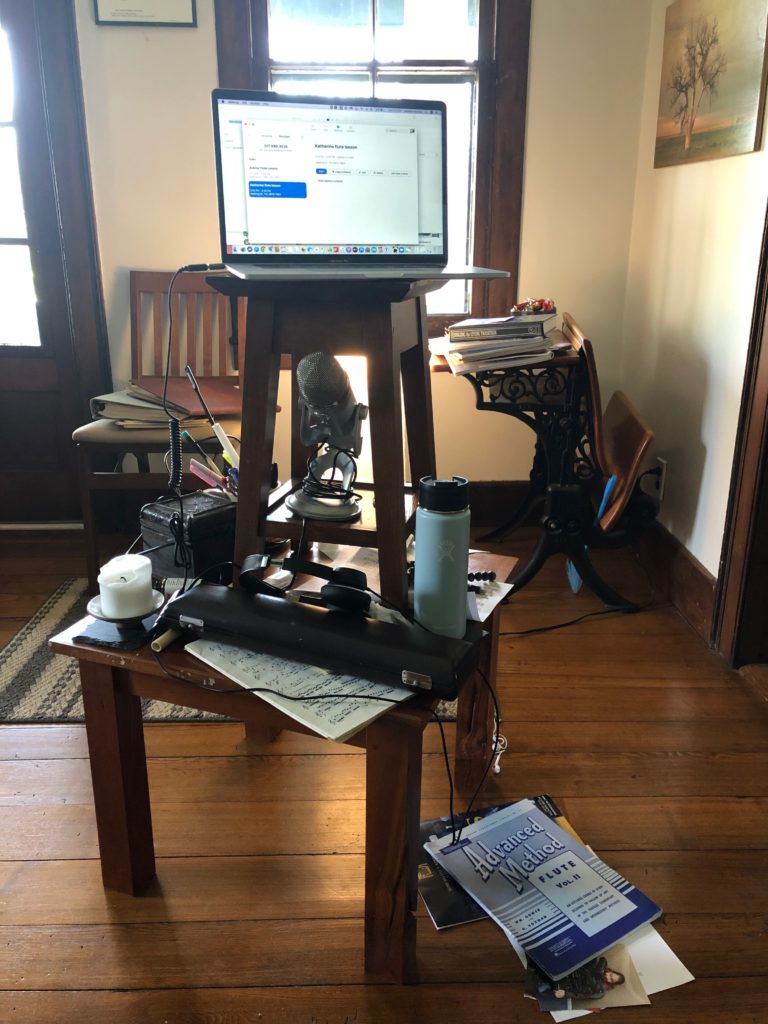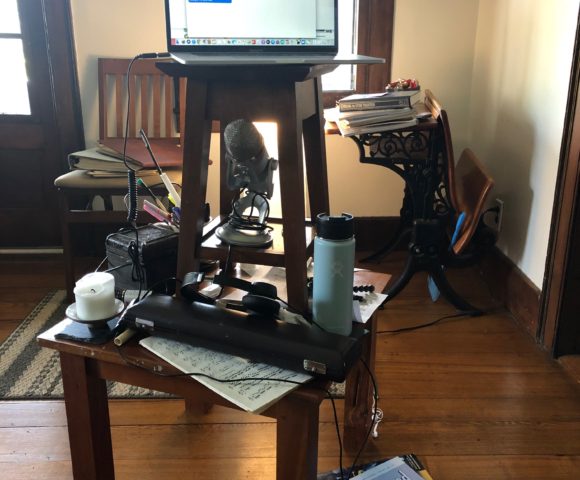Virtual Music: Teaching Lessons Online: The Good
I began teaching lessons online in the middle of March 2020, as soon as the Governor of the State of Ohio issued stay-at-home orders.
It happened very quickly. In fact, just a day before, I was teaching lessons in the home studio and thought that I would see my students the next week. I gave assignments as usual.
The last time a student walked through the front door was over 70 days ago.
In this blog article, I’m going to discuss some of the good changes that have happened in the studio as a result of the pandemic.
Everything Changed
Like most people, I was not prepared for the sweeping changes that the global pandemic would cause. On March 13, the kids went to school and there were whispers of “quarantine,” but none of us really knew what that meant. I remember thinking that it might be nice to have a break and wondering what essentials I might need for staying at home for two weeks.
We had a family conversation about what things we would be demoralized without. The list was short: coffee, dishwashing detergent, electricity, X-box, Oreos, cheese, and black beans.
Now I look back on that conversation and realize how naive we were. This was not going to be like a snowstorm. I could not have imagined what was going to happen and how it would upend my life.
While our family has done a good job adapting to the many changes, it has been tricky at times. My first blog article on the subject was bubbling with enthusiasm. It has become more difficult with time. However, I believe we are all learning important lessons for living.
Online Teaching
I didn’t waste any time switching to online lessons. My students were quickly transitioning to online school, the church was going virtual, and I had some experience doing Zoom meetings for one of my other jobs.
It took a few tries to get the laptop in the right place, find a headset, adjust the audio settings, and rearrange the studio. Musicians in my networks were working with the same issues and they freely shared their wisdom: have the camera at head height or slightly above for the best angle, don’t sit in front of a window – the backlighting is bad, use a headset to prevent an echo.

Notice the candle for lighting my personal chalice during online worship services for NUUC, a water bottle, stacks of music, headphones, and a Blue Yeti microphone.
For online lessons, I need to have copies of all of the books that my students are working out of. This meant that I had to buy some music. Because I cannot look at their score while they are playing, I have to follow along with my own books.
I am also unable to loan materials to my students. Before the pandemic, if a student needed to borrow a book, I would give it to them to take home. No more. Now, I have to ask the students to order and purchase the music or use the IMSLP.
The Platforms
I use three different platforms with my students, led by their familiarity with the technology.
My favorite is Zoom because it has the best audio settings. I also like that I can schedule the “meeting” and send an invitation. All the student has to do is click on the link at the time of the lesson. I can also set it up to send reminders and add the event to my calendar. Additionally, Zoom allows me to share my screen and write on a whiteboard. It also has virtual backgrounds, which is fun.
With one of my students, we use Facebook Messenger Video. Her internet is not fast, but this platform seems to run on a lower bandwidth than Zoom. When we used Zoom, it would often freeze or have strange audio. Facebook has been reliable but the overall audio and video are not clear.
Another family prefers FaceTime. They have Apple devices and I do too, so it works great. My son’s piano teacher also uses FaceTime for his lessons. The audio seems good, though high notes sound tinny and shrill. We have fun turning ourselves into Animojis. Have you ever heard a flute-playing fox?

For a consulting job, I have used Google Hangouts. This is my least favorite platform. I find that the video and audio are unstable. My kids use Google Meet for some of their school meetings, but they also complain about this platform. (Can anyone tell me what the difference is between Google Hangouts and Google Meet?)
The Pros of Online Lessons
Once we figured out the technical issues, my students and I settled into a comfortable lesson routine.
I have enjoyed seeing the houses and pets of my students. One sweet guinea pig named Reece likes to run around in the background during lessons, which was distracting at first, but now I’m used to seeing a large rodent running across the floor! The “pandemic puppy” named Cocoa is growing every week. He howls when the kids play high notes.

Cats seem to like video-bombing lessons. They walk leisurely in and out of the room. They walk on the computer keyboard. My cats make appearances too. I think they miss the students as much as I do.
The usually exhausted teens are now perky in their lessons, and uncharacteristically chatty. I’ve noticed this in my own teens. Now free to set their own schedules, their mornings are leisurely. When they see other people, they are excited to interact. I think the typical school day, which starts at 7:30 and has a lot of social pressure is exhausting for many people. I have students who report that on a normal school day, they wake up at 5:30am. Now they get to sleep in until 8:00 or 9:00am. During their afternoon lessons, they have better attention spans and are more pleasant.
Video
Flutists are unable to see their fingers as they play. On most other instruments, musicians can see their hand position and correct it. During the online lessons, we have been using the video to fix hand and body positions. I ask students to play something from memory, like a scale, while watching their fingers. We look for tension in the hands, ergonomics, and distance to the keys. The video has been a tremendous asset to my teaching.
We also use the video to look at the embouchure, which is not easy to do in-person. During in-person lessons, I would not feel comfortable being super close to a student’s mouth, but we can use the video camera to get close without invading personal space. I can bring my camera close to show small movements of the lips when changing octaves, talk about tongue placement, and refine the embouchure shape.
Close-ups of my mouth are informative, but we always end up laughing. I feel like this:

Audio
When I am teaching, I wear a headset. This allows me to block out the noise coming from the other people in my house (especially those who are loud when playing video games with their friends…), prevents an echo, and allows me to hear my students more clearly.
I can hear every breath, every articulation in a way that I can’t in the studio where the sound is more acoustically live and my ears are farther away from the student’s mouth. I have become very picky about correct articulations. Moreover, I was able to discover that one student was exhaling through the nose at the end of phrases. Even though I had suspected this before, with the microphone up close, I was able to hear it clearly.
No Students = Opportunity To Make A Mess
The studio is a bit of a mess right now. We are re-organizing the sheet music and there are piles on chairs, something I would not have allowed before. We also took this rare opportunity to paint the downstairs bathroom and fix the cracks in the walls. This also would have been very difficult at any other time because students and their parents use this bathroom.
I Miss My Students
Virtual lessons are not the same as in-person lessons, but at this time, they are the safest option. I continue to monitor the recommendations from the CDC and the State of Ohio. New research on the spread of coronavirus particles is published every week.
These virtual lessons have made me become more flexible and creative as a teacher. I’ve learned new skills and been able to connect in new ways. In the next blog article, I will discuss some of the difficulties with virtual lessons.

4 comments